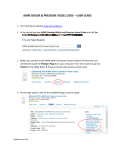Download UBReader2 Security Target
Transcript
UBREADER2
SECURITY TARGET
VERSION 1.12
2011-12-05
Hitachi-Omron Terminal Solutions, Corp.
.
1
Table of content
DOCUMENT INTRODUCTION ............................................................................................. 4
1.
2.
3.
4.
ST INTRODUCTION ....................................................................................................... 4
1.1.
ST AND TOE REFERENCE ............................................................................................... 4
1.2.
TOE OVERVIEW .............................................................................................................. 5
1.3.
TOE DESCRIPTION .......................................................................................................... 5
CONFORMANCE CLAIMS ............................................................................................ 19
2.1.
CC CONFORMANCE CLAIMS .......................................................................................... 19
2.2.
PP CLAIM ...................................................................................................................... 19
2.3.
PACKAGE CLAIM............................................................................................................ 19
SECURITY PROBLEM DEFINITION ........................................................................... 20
3.1.
EXTERNAL ENTITIES...................................................................................................... 20
3.2.
ASSETS .......................................................................................................................... 20
3.3.
ASSUMPTIONS ............................................................................................................... 22
3.4.
THREATS ....................................................................................................................... 24
3.5.
OSPS ............................................................................................................................. 26
SECURITY OBJECTIVES ............................................................................................. 27
4.1.
SECURITY OBJECTIVES FOR THE TOE .......................................................................... 27
4.2.
SECURITY OBJECTIVES FOR THE OPERATIONAL ENVIRONMENT .................................... 27
4.3.
SECURITY OBJECTIVES RATIONALE............................................................................... 30
5.
EXTENDED COMPONENT DEFINITION ................................................................... 33
6.
SECURITY REQUIREMENTS ...................................................................................... 34
7.
6.1.
SECURITY FUNCTIONAL REQUIREMENTS FOR THE TOE ............................................... 34
6.2.
SECURITY ASSURANCE REQUIREMENTS FOR THE TOE................................................. 37
6.3.
SECURITY REQUIREMENTS RATIONALE ......................................................................... 38
TOE SUMMARY SPECIFICATION............................................................................... 41
2
8.
7.1.
DATA PROTECTION ........................................................................................................ 41
7.2.
I&A ............................................................................................................................... 42
7.3.
TAMPER RESISTANCE .................................................................................................... 42
APPENDIX ..................................................................................................................... 44
8.1.
REFERENCES ................................................................................................................. 44
3
D OCUMENT I NTRODUCTION
This Security Target (ST) was developed based on the Biometric Verification Mechanisms
Protection Profile v1.3 [BVMPP]. However, it does not claim conformity to this PP.
1. ST I NTRODUCTION
1.1. ST
AND
TOE R EFERENCE
ST Title:
UBReader2 Security Target
ST Version:
1.12
ST Date:
2011-12-05
ST Author:
Hitachi-Omron Terminal Solutions, Corp.
CC-Version:
3.1 Release 3
Keywords:
authentication; biometric; identification; verification; finger vein
TOE:
Finger Vein Authentication Device UBReader2 and its related guidance
documentation [AGD]
<Model: TS-E3F1-700UW / TS-E3F1-700UWP>
<Hardware: D, Software: 03-00>
Developer:
Hitachi-Omron Terminal Solutions, Corp.
4
1.2. TOE O VERVIEW
The scope of this Security Target (ST) is to describe the functionality of the Finger Vein
Authentication Device UBReader2 (UBR2) as a biometric system in terms of [CC] and to
define functional and assurance requirements for it.
In this context the major scope of the UBR2 as a biometric system is to verify or reject a
human being using a pattern of his or her finger vein as unique characteristics of his or her
body. The TOE is used by an application (e.g. a portal) which utilizes the functionality of the
TOE to verify the identity of a user. The TOE requires other components in its operational
environment which are identified in chapter 1.3.6.
Please note that inside this ST the enrolment and the identification process of a biometric
system (see also chapter 1.3.2) are not considered. Chapter 1.3 gives a more details overview
about the design of the TOE and its boundaries.
1.3. TOE D ESCRI PTION
The TOE provides a biometric verification process for the claimed identity of a human being
using a pattern of his or her finger vein as unique characteristic of their body.
The basic processes of a biometric system are described in chapter 1.3.2.
This ST describes a biometric system that operates in a verification mode only. Biometric
Identification is not addressed with in this ST. Furthermore the enrolment process is out of
scope of this ST and it is assumed that all authorized users have been enrolled. Last but not
least the TOE aims to verify the identity of a user for the purpose of controlling access to a
portal.
Such a portal can be a physical or logical point beyond which information or assets are
protected by the biometric system. With failed biometric verification, the portal stays closed
for the user. Only after successful biometric verification, the portal will be opened.
5
Therefore, such a portal requires one of two states after biometric verification: failed or
successful authentication of the user. The final decision on the claimed identity of the user
(resulting from a biometric probabilistic message into a boolean value) is considered to be
part of the TOE. Everything beyond the portal and the control of the portal itself (i.e. which
users have access to the portal) is out of the scope of the TOE.
Beside the biometric verification process every biometric system needs to include
mechanisms to identify and authenticate an administrator of the system with other means
than the biometric mechanism and to limit the access to administrative functions. This is
specifically important to limit the ability to change security relevant settings of the
biometric functionality to an authorized administrator. The TOE is used as a part of an
overall application. Identification and authentication of an administrator needs to be
handled by this application, which is part of the operative environment of the TOE.
Therefore this requirement is not handled by the TOE but by the operative environment.
1.3.1. W OR D I N G
I N C O N TE X T O F
C O M M O N C RI TE RI A
In context of [CC] identification usually means the statement of a claimed identity whole
authentication means the confirmation of this identity. In context of biometric technology
identification usually means a process as described in chapter 1.3.2. To avoid any
misunderstanding: the wording in this ST is as follows:
-
Identification: As defined in [CC]
-
Authentication: As defined in [CC]
-
Biometric identification: Biometric identification as described in chapter 1.3.2
-
Biometric verification: Biometric verification as described in chapter 1.3.2
1.3.2. D E S C R I P TI O N
O F GE N E RA L B I O M E TRI C P R OC E S S E S
The general core functionality of biometric systems can be divided into three processes:
6
-
Enrolment1:
Usually, the enrolment process is the first contact of a user with a biometric system.
This process is necessary because a biometric system has to ‘learn’ to verify the identity
of each user based on their biometric characteristic.
During the enrolment process the system captures the biometric characteristic of a user
and extracts the features it is working with. This feature vector is then combined with
the identity of the user to a biometric reference and stored in a database.
The quality of the biometric reference has to be assured and quality proofed. In the case
of inadequate biometric characteristics or lower reference quality, the person to be
enrolled has to repeat the process or is not possible to be enrolled. Only an
administrator should be allowed to start the enrolment process. The administrator has
to observe the whole process to ensure a correct enrolment. Furthermore, the
administrator has to ensure that the user claims his correct identity to the system
during the enrolment process.
-
Biometric Verification:
An objective of the biometric verification process is to verify or refuse a claimed identity
of a user.
Therefore the user has to claim an identity to the system. The system gets the biometric
reference associated with this identity from the database and captures the biometric
characteristic of the user. If the Biometric Live Record (BLR) that is extracted from the
characteristic and the biometric reference from the database are similar enough, the
claimed identity of the user is verified.
Otherwise or if no biometric reference was found for the user, the claimed identity is
refused. The matching component of a biometric system that decides whether a
As mentioned before: Within this ST is assumed that the enrolment process for all users
has already been performed.
1
7
biometric reference and BLR are similar enough usually uses a threshold value for this
decision that can be configured by an administrator. If the matcher finds that the BLR
and the biometric reference are more similar than demanded by the threshold, it
returns successful verification, otherwise failed verification.
-
Biometric Identification2:
An objective of the biometric identification process is quite similar to a biometric
verification process. However, in contrast to a biometric verification process there is no
claimed identity for the user. The system directly captures the biometric characteristic
of a user and compares it to all biometric references in the database.
If at least one biometric reference is found to be similar enough, the system returns this
as the found identity of the user. Biometric identification systems introduce many
additional issues in the context of security evaluations. The possibility to find more
than one biometric reference that matches or the higher error rates of those systems are
only two of them.
The biometric identification process is not part of the TOE and therefore out of scope of
this ST.
2
8
Biometric Verification
ID and Biometric
Reference Record Request
Live Biometric
Characteristic Request
Comparison with
ID Templates
Correspondence
(yes / no)
F IGURE 1: V ERIFICATION
1.3.3. TOE
C O N FI GU R A TI O N A N D
TOE
FLOWCHART
E NV I R ON ME N T
The [BVMPP] mentioned that a biometric system in general could be realized in two major
configurations:
-
A Stand-alone solution:
The stand-alone solution is not integrated into another network and works with one
database
-
A Network-integrated solution:
The network-integrated solution is embedded into an existing network.
This ST describes a biometric system for biometric verification.
The performance of biometric systems depends on physical environmental conditions in its
environment. This ST specifies how the environment has to be for the TOE. The ST also
9
specifies the IT components which are necessary to run the TOE (e.g. a PC with a specific
operation system).
1.3.4. TOE
B OU N D A R Y
Figure 2 shows the specific function of the TOE.
In this ST, the capture device is a part of the TOE.
The database where the biometric references and other information is stored in, is a part of
the TOE.
User
Biometric
Characteristic
Claimed
Identity
AuthAdmin
Set
Configuration
Policy Management /
Access Control
GetID
Portal
Finger IDs
Get
References
Get
Configuration
Database
Finger ID,
Failure /
Success
Comparator
Capture
Device
Capture
Control
Check
Extraction
Clear
Memory
Tamper
Resist
TOE Boundary
F IGURE 2: S PECIFIC TOE
DESIGN FOR BIOMETRIC VERIFICATION
10
-
Get ID:
When a UserID is inputted into this component, it outputs FingerIDs corresponding to
the UserID. The reason why FingerIDs become plural is that one user can enroll his/her
vein information for multiple fingers,.
In this ST, this component is outside of the TOE, the application using the TOE needs
handle claimed identities. The application decides Finger IDs (unique ID labeled to
biometric references) that corresponds to identity obtained from the user, and sends
Finger IDs to the TOE.
-
GetReferences (same as GetRef):
This component receives FingerIDs outputted by GetID and extracts corresponding
biometric references from the database.
In this ST, this is part of the TOE.
The TOE receives Finger IDs sent from the application and gets corresponding biometric
references from a database.
-
Extraction:
In preparation of the biometric verification process a feature vector has to be extracted
from the captured data. This is the objective of this component.
In this ST, this is part of the TOE. In addition to the general model of [BVMPP] the TOE
specific Figure 2 contains an additional block called “capture control”. This indicated the
fact, that the TOE contains functionality to control the capture device.
-
Check:
This component ensures the minimum quality requirements regarding the biometric
references. It can be differentiated into integrity and authenticity check during the
process of getting the biometric reference as well as the quality check of the biometric
information during the processing of the live biometric characteristics.
In this ST, the TOE checks integrity and authenticity of all the biometric references
stored in a database when the TOE starts. So the TOE does not check integrity and
authenticity of the biometric references in each biometric verification process (therefore,
11
the component “Check” of biometric references is not described in Figure 2). A quality
check of live biometric characteristics is done in biometric verification process.
-
AuthAdmin:
This component is responsible for identification and authentication of the administrator
with other means than the biometric mechanism itself. This mechanism is a classical
identification and authentication component that could for example be realized via a
SmartCard/PIN based mechanism. It is necessary to authenticate an administrator
before configuring security relevant settings of the TOE.
In this ST, this component is outside of the TOE scope. The application using the TOE
needs to implement this functionality.
-
Set Configuration:
This component provides an interface for the administrator to set security relevant TOE
parameters. And this component gets over to Store Configuration. This component is
especially used to configure the threshold setting for the comparator component.
In this ST, this component is outside of the TOE. Therefore the application developer
using the TOE needs to implement configuration management in the application.
-
Get Configuration:
This component provides an interface to receive the security relevant TOE parameters
which is set by Set Configuration. And this component stores and manages the security
relevant TOE parameters in TOE.
In this ST, this component is a part of TOE.
-
Comparator (also called Matcher):
This component compares biometric references extracted by GetReference with
Biometric Live Record (BLR). It corresponds to the Figure 1 on the whole since it takes
User ID as argument and compares biometric references with BLR.
This is an important component regarding the scope of this ST. It compares the enrolled
biometric reference with the Biometric Live Record (BLR) and includes the
determination whether these records match or not. A comparator produces a value that
12
shows how well the biometric reference and BLR match. To get a successful/failed return
value from the biometric system, the comparator considers a threshold during the
matching process. If the biometric reference and the BLR are more similar than
demanded by the threshold, the result of matching is success, otherwise it is fail.
The TOE compares biometric references, and returns Finger ID to the application if
biometric reference by which the result of matching becomes success is only one.
On the other hand, when there are two or more biometric references by which the result
of matching becomes success, or the result of all biometric references becomes fail, the
TOE returns "failure" to the application.
When "Exact match" comparison, that is, value that shows how well the biometric
reference and BLR match is zero, it is not judged the result success.
-
Clear memory:
In order to protect against attacks, this component clears the content of memory after
use. The information that has to be cleared is not limited to the biometric verification
result but especially includes the biometric reference, BLR or any biometric raw data.
In this ST, the biometric references are cleared when the TOE is shut down, and BLR or
any biometric raw data is cleared when the biometric verification process is finished.
Because the memory that has to be cleared could belong to every other component no
lines are drawn into the figure for this component.
For the data under control of the application using the TOE, that application itself is of
course responsible.
-
Capture Device:
This component that is also called sensor is responsible for capturing the biometric
characteristic from the user. Depending on the used sensor technology also additional
processes as a spoof detection or an image enhancement could be performed by this
device.
The capture device is a part of the TOE.
-
Policy manager:
The result of the biometric verification process is passed on to the policy manager of the
13
environment. This component is responsible for checking the user’s rights and opening
the portal if the user has sufficient privileges and was successfully verified by the TOE
and is therewith realizing an access control mechanism for the portal.
As mentioned before the TOE passes the result of the comparator to the application
which uses the TOE. All more specific decisions (whether a user with a specific identity
has specific rights for the Portal Service) is up to the application or to the Portal Service
itself. In any case the Policy Manager is outside the TOE.
-
Storage:
The TOE has to provide a database. This is used to store the biometric reference of a
user but it can be used to store additional information too.
UBR2 has the case to use database outside and inside. In this ST, only the case with
database inside the TOE is targeted.
-
Portal:
The physical or logical point beyond which information or assets are protected by the
TOE is controlled by the TOE environment policy management, which gets the biometric
verification results ("failed" or "successful") from the TOE.
As mentioned before the specific connection to the Portal Service is out of scope of the
TOE and depends on the overall application using the TOE.
-
Transmission / Storage:
The environment cares for a secure communication and storing where security relevant
data is transferred to or from the TOE.
-
Tamper Resist:
This component is responsible for resisting the physical tampering to the UBR2 device
while the TOE is running. IF UBReader2 is opened physically, this component deletes
data in the SDRAM of the TOE and the authentication engine and templates in flash
memory are deleted. Afterwards, UBR2 will be locked even if it is rebooted.
14
1.3.5. P H YS I C A L S C OP E
AND
L O GI C A L S C OP E
A simplified model of the TOE and its boundaries is shown in Figure 3. The capture device is
UBR2
Driver
Upper
application
displayed in Figure 4.
Authentication Engine
USB2.0/
RS232C
Firmware
Capture Device
OS
UBR2 Device
PC
: TOE
F IGURE 3: P HYSICAL S COPE
F IGURE 4: C APTURE D EVICE
In contrast to the model assumed by the [BVMPP] the capture device is a part of the TOE,
see the TOE boundary indicated in Figure 2. Therefore the TOE is not a pure software
system. It therefore consists of two parts as shown in Figure 3.
15
-
The software part of the TOE is a device driver including an API which is used by an
application running on a PC.
-
The hardware part of the TOE is a device (which itself also contains firmware for its
internal operation).
There are two kinds of models of UBR2 device. The difference of each model is only presence
of the cable dropout prevention mechanism. The difference is not provided as security
functionality in the device.
The TOE is accompanied by its related guidance documentation.
The logical scope of the TOE is best described by enumeration of the provided security
functionality:
Verification of user identity with finger vein patterns (1:1 matching using device
internal database)
Data protection by deletion of residual information
Protection against physical tampering and replay attacks
Functionality that builds up a trusted channel between UBReader2 device and the device
driver is not part of the TOE security functionality.
The TOE contents can be described as follows:
16
T ABLE 1: TOE
CONTENTS
TOE contents
Reference / Version
UBReader2 device
TS-E3F1-700UW (USB interface model)
TS-E3F1-700UWP (USB interface model
with cable dropout prevention mechanism)
Revision
D
Firmware
020300
Engine
020300
Driver
010400
Firmware INI
010002
UBReader2 Programs & Documents
TS-E3F1-70WCD Ver.03-00
Device driver
03-00-00
UBReader2 Users Manual
See [USR_MAN]
UBReader2 Device Driver Installation
03
Manual
UBReader2 Extra Error Code
02
UBReader2 Finger Placement Guide
01
CC Guidance Addendum
See [AGD]
Note: Users shall contact a sales representative of Hitachi-Omron Terminal Solutions in
order to learn how to verify the integrity of the CD-ROM. The necessary process is also
described in [AGD].
1.3.6. N O N -TOE H A R DW A R E , S OF TW A RE ,
OR
F I R MW A RE
The following hardware and software is required for the operating environment:
-
Hardware (Standard PC)
Required free RAM: min. 3MB
Required free HDD memory: min. 5MB (except for log data)
Connection interface: USB1.1/USB2.0
17
-
Software (OS)
Windows® XP Professional (32bit), Windows Vista® Business (32bit),
Windows® 7 Professional (32 bit)
-
Software (Application)
An application that utilizes UBReader2 and integrates its device driver to provide
authentication functionality and management functionality to administrators.
18
2. C ONFORMANCE C LAIMS
2.1. CC C ONFORMANCE C LAI MS
This ST has been developed using Version 3.1 R3 of Common Criteria [CC].
This ST is conform to part 2 and 3 of [CC]; no extended components have been defined.
2.2. PP C LAI M
This ST does not claim conformance to any Protection Profile.
2.3. P ACKAGE C LAI M
This ST conforms to assurance package EAL2 as defined in Common Criteria Part 3.
19
3. S ECURITY P ROBLEM D EFINITION
3.1. E XTERNAL
ENTITIES
The following external entities interact with the TOE:
-
Application developer:
The application developer integrates the TOE in its own application (e.g. a portal) by
accessing the device driver of the TOE.
-
Administrator:
The administrator is authorised to perform the administrative operations and able to
use the administrative functions.
The administrator is also responsible for the installation and maintenance of the TOE
and the application.
-
User:
A person who wants access to the portal, which is protected by the TOE.
-
Authorised user:
An enrolled user with an assigned identity.
-
Attacker:
An attacker is any individual who is attempting to subvert the operation of the TOE.
The intention may be to gain unauthorized access to the assets protected by the portal.
3.2. A SSETS
The following assets are defined in the context of this ST.
-
Primary assets:
The primary assets which are protected against unauthorised access do not belong to the
TOE itself. The portal in the environment permits access only after successful
20
authentication as a result of the biometric verification. The primary assets, either
physical or logical systems, are behind that portal.
-
Secondary assets:
Assets (i.e. TSF data), which are used by the TOE itself. The following assets should be
explicitly mentioned:
►
Biometric Reference Record (BRR):
This object includes the enrolled biometric data labeled finger ID which is linked
with the identity of a user. It is produced during the enrolment process and
assumed to be given and quality checked. Finger ID, that is, correspondence
between enrolled biometric data and identity of a user is managed by the
application which uses the TOE. Therefore, the way of implementation for
management is depending on the application, and the protection of the
correspondence information is responsibility of the application.
►
Biometric Live Record (BLR):
This record includes the live (actual)
biometric data (actual biometric
characteristic) to be verified against the biometric reference.
►
Threshold level:
Threshold level is sent from the application that uses TOE to the TOE each time
the biometric verification process is initiated.
►
Boolean match decision:
The Boolean match decision is returned by the device to indicate whether a
biometric verification was successful or not.
►
Pairing key:
The pairing key is used to associate a UBReader2 device with a device driver
installed on a PC. The key is generated by the device driver and sent to UBReader2
device during initialization.
21
3.3. A SSUMPTIONS
A.ADMINISTRATION
The administrator is well trained, non hostile, and reads the guidance documentation
carefully, completely understands and applies it.
The administrator is responsible to accompany the TOE installation and oversees the
biometric system requirements regarding the TOE as well as the TOE settings and
requirements.
A.ENROLMENT
The enrolment is assumed to be already securely performed and therefore, the biometric
reference for each authorized user is assumed to be given. The generated reference is of
sufficient quality and is linked to the correct user.
A.ENVIRONMENT
It is assumed, that necessary TOE operating equipment and adequate infrastructure is
available (e.g.: operating system, database, LAN,
and guardian).
Specifically the following things are assumed:
-
It is assumed that the direct environment of the TOE supports the functionality of
the TOE. Regarding the request of the claimed identity, which is necessary for the
biometric authentication, the environment offers the possibility to integrate a
claimed identity into the biometric verification process.
-
The environment is assumed to implement the access control functionality for the
protected portal. Specifically, if the environment has more than one portal that is
secured using the services of the TOE the environment is assumed to ensure that
after authentication of a user (by the TOE) a portal is only opened if the user has the
necessary permission.
-
The environment is assumed to ensure a secure communication of security relevant
data from and to the TOE.
22
-
The environment ensures a secure communication between the TOE components by
physical means.
-
It is assumed that the TOE environment is free of viruses, trojans, and malicious
software.
-
The TOE is a piece of equipment that uses near-infrared light to capture finger vein
data without being in physical contact with the finger. Thus the near-infrared light
from natural light (sunlight), incandescent lamps, mercury lamp and halogen lamps
in the environment can reduce the authentication accuracy. Therefore it is assumed
that the capture device is not exposed to direct sunlight, incandescent lamps,
mercury lamp and halogen lamps.
-
The UBReader2 device is assumed to be stored in a secure environment (e.g. locked
storage room) whenever it is not in use and powerless. Before the powerless device is
brought into operation, the administrator is assumed to check the security seal and
verify that the device has not been opened.
A.PHYSICAL_DRIVER
It is assumed that the UBReader2 device driver installed on the PC is physically
protected against unauthorized access or destruction. Physical access to PC is only
allowed for authorized administrators. This does not cover the UBReader2 device that
has to be accessible for every user.
A.FALLBACK
It is assumed that a fall-back mechanism for the TOE is available that reaches at least
the same level of security as the TOE does. This fall-back system is used in cases where
an authorized user is rejected by the TOE (False Rejection).
A.ROLES
An application using the TOE shall restrict its management functionality to
authenticated and authorized administrators. Other users are not allowed to manage the
TOE.
23
A.AUTH_ADMIN
An application using the TOE shall provide a mechanism to authenticate an
administrator with other means than the biometric verification process. This
authentication process may be realized via a user name/password or a smartcard/pin
based mechanism.
3.4. T HREATS
T.BRUTEFORCE
An attacker may perform a brute force attack in order to get verified by the TOE using
the identity of another user.
In this way the attacker is trying to get access to the assets residing in the environment
that should be protected with the support of the TOE.
This threat considers two different threat agents and corresponding adverse actions:
-
A not really hostile user who just tries to get verified with a wrong claimed identity a
few times. The motivation of such a user is usually just curiosity. The hostile user
does not need specific knowledge about the TOE to perform this attack.
-
A real attacker who uses a large amount of biometric characteristics and who really
wants to get unauthorized access to the portal. This type of threat agent is supposed
to have further public knowledge on biometric systems.
T.MODIFY_ASSETS
An attacker may try to modify secondary assets like biometric references, threshold,
pairing key, or the boolean decision.
Such attacks could compromise the integrity of the user security attributes resulting in
an incorrect result that might give unauthorized access to the portal.
This threat covers a number of distinct types of attacks:
24
-
An attacker may attempt to modify the threshold level used by the TOE to
authenticate users. If the attacker is able to change the threshold (for one or more
authorised users), the ability to verify the user(s) will be compromised and the
attacker may succeed in gaining access to the portal or an authorised user may be
denied entry to the portal.
-
An attacker may attempt to modify the Boolean match decision, the pairing key, or
the biometric authentication data (the Biometric Reference Record) of an authorised
user with the aim of enabling an attacker to masquerade as the authorized user and
gain access to the portal. Alternatively, an authorised user may be denied access to
the portal. The attacker may be able to insert a new biometric reference, containing
biometric data belonging to an attacker, with the aim of enabling the impostor to
gain access to the portal.This kind of attack presupposes that the attacker has
further knowledge about the TOE and maybe special equipment.
T.REPRODUCE
An attacker may try to record and replay, imitate, or generate the biometric
characteristic of an authorised user.
In this way the attacker is trying to get access to the assets residing in the environment
that should be protected with the support of the TOE.
The attacker will need further knowledge on biometric systems and the used biometric
modality. Attackers may use technical equipment for analysing and generation of the
biometric characteristics.
The attacker may also be supported by an authorized user of the TOE (e.g. to imitate his
biometric characteristic).
T.RESIDUAL
An attacker may try to take advantage of unprotected residual security relevant data
(e.g. biometric data and settings) during a user's session or from a previous, already
authenticated user.
25
In this way the attacker tries to get access to the security relevant settings of the TOE.
This threat covers a following scenario including:
-
An attacker takes advantage of the verification memory content (e.g. by reading the
memory content, cache or relevant temporary data) using a flaw in a user visible
interface of the TOE.
The attacker needs further knowledge about the TOE to find and exploit a vulnerability
regarding residual data in memory.
Note: Because the TOE reads biometric characteristics from the vein structure of a finger,
residual fingerprint images on the surface of the capture devices cannot be used by
attackers to copy or replay the biometric characteristics.
3.5. OSP S
OSP.ERROR
The TOE shall meet recognised national and/or international criteria for its security
relevant error rates (e.g. False Accept Rate (FAR) and False Rejection Rate (FRR)).
For the TOE a FAR of less than 0.001 is claimed.
26
4. S ECURITY O BJECTIVES
4.1. S ECURITY O BJECT IVES
FO R THE
TOE
O.BIO_VERIFICATION
The TOE shall provide a biometric verification mechanism to ensure access to a portal
with an adequate reliability.
The TOE shall ensure that only suitable biometric references (i.e. records that have been
created and stored by the TOE itself) are processed.
An “Exact match” comparison should not be counted as a positive verification as it may be
a replay attempt.
The TOE shall meet national and/or international criteria for its security relevant error
rates. For the TOE a FAR of less than 0.001 is claimed.
The TOE shall not authenticate forged biometric samples.
O.RESIDUAL
The TOE shall ensure that no residual or unprotected security relevant data remains
after operations are completed.
O.PHYSICAL_DEVICE
TOE shall be able to resist physical tampering to the device under operation.
4.2. S ECURITY
OBJECTIVES
F OR
THE
OPERATIONAL
ENVI RONMENT
OE.ADMINISTRATION
It has to be ensured that the administrator is well trained, non-hostile, and has to read
the guidance documentation carefully, completely understand and apply it.
27
The administrator shall be responsible to accompany the TOE installation and oversees
the biometric system requirements regarding the TOE as well as the TOE settings and
requirements.
OE.ENROLMENT
The enrolment shall be already performed and therefore, the biometric reference for each
authorized user is given. The generated references shall be of sufficient quality and
linked to the correct user.
OE.ENVIRONMENT
The TOE operating equipment and adequate infrastructure shall be available (e.g.:
operating system, database, LAN, public telephone, and guardian).
Specifically the following things have to be ensured:
-
The direct environment of the TOE has to support the functionality of the TOE.
Regarding the request of the claimed identity, which is necessary for the biometric
authentication, the environment shall offer the possibility to integrate a claimed
identity into the biometric verification process.
-
The environment has to implement the access control functionality for the protected
portal. Specifically, if the environment has more than one portal that is secured
using the services of the TOE the environment has to ensure that after
authentication of a user (by the TOE) a portal is only opened if the user has the
necessary permission.
-
The environment shall ensure a secure communication of security relevant data
from and to the TOE.
-
The environment shall ensure a secure communication between the TOE
components by physical means.
-
The TOE environment has to be free of viruses, trojan horses, and other malicious
software.
28
-
The TOE environment shall provide reliable time stamps.
-
The TOE is a piece of equipment that uses near-infrared light to capture finger vein
data without contacting the finger. Thus the near-infrared light from natural light
(sunlight), incandescent lamps, mercury lamp and halogen lamps in the
environment can reduce the authentication accuracy. Therefore the capture device is
not exposed to direct sunlight, incandescent lamps, mercury lamp and halogen
lamps.
-
The UBReader2 device shall be stored in a secure environment (e.g. locked storage
room) whenever it is not in use and powerless. Before the powerless device is
brought into operation, the administrator shall check the security seal and verify
that the device has not been opened.
OE.PHYSICAL_DRIVER
The PC installed the UBReader2 device driver shall be physically protected against
unauthorized access or destruction. Physical access to the PC may only be allowed for
authorized administrators. This may not cover the UBReader2 device that has to be
accessible for every user.
OE.FALLBACK
A fall-back mechanism for the TOE shall available that reaches at least the same level of
security as the TOE does. This fall-back system is used in cases where an authorized user
is rejected by the TOE (False Rejection).
OE.ROLES
An application using the TOE shall restrict its management functionality to
authenticated and authorised administrators. Other users are not allowed to manage the
TOE.
OE.AUTH_ADMIN
An application using the TOE shall provide a mechanism to authenticate an
administrator with other means than the biometric verification process. This
29
authentication process may be realized via a user name/password or a smartcard/pin
based mechanism.
4.3. S ECURITY O BJECT IVES
RATIONALE
4.3.1. O V E R V I EW
The following table gives an overview, how the assumptions, threats, and organisational
security policies are addressed by the security objectives. The text of the following
subchapters justifies this more detailed.
T ABLE 2: S ECURITY O BJECTIVES R ATIONALE
OE.AUTH_ADMIN
OE.ROLES
OE.FALLBACK
OE.PHYSICAL_DRIVER
OE.ENVIRONMENT
A.ADMINISTRATION
OE.ENROLMENT
X
X
T.RESIDUAL
OSP.ERROR
OE.ADMINISTRATION
X
T.MODIFY_ASSETS
T.REPRODUCE
O.PHYSICAL_DEVICE
O.RESIDUAL
O.BIO_VERIFICATION
T.BRUTEFORCE
X
X
X
X
X
X
X
A.ENROLMENT
X
A.ENVIRONMENT
X
A.PHYSICAL_DRIVER
X
A.FALLBACK
X
A.ROLES
X
A.AUTH_ADMIN
X
30
4.3.2. C O V E R A G E
The
assumption
OF T H E A S S U MP TI O NS
A.ADMINISTRATION
is
covered
by
security
objective
OE.ADMINISTRATION as directly follows.
The assumption A.ENROLMENT is covered by security objective OE.ENROLMENT as
directly follows.
The assumption A.ENVIRONMENT is covered by security objectives OE.ENVIRONMENT
as directly follows.
The assumption A.PHYSICAL_DRIVER is covered by objective OE.PHYSICAL_DRIVER as
directly follows.
The assumption A.FALLBACK is covered by objective OE.FALLBACK as directly follows.
The assumption A.ROLES is covered by objective OE.ROLES as directly follows.
The assumption A.AUTH_ADMIN is covered by objective OE.AUTH_ADMIN as directly
follows.
For all assumptions, the corresponding objectives are stated in a way, which directly
correspond to the description of the assumption. It is clear from the description of each
objective that the corresponding assumption is covered.
4.3.3. C O U N TE R I N G
TH E T H R E A T S
The threat T.BRUTEFORCE (using a large amount of possible biometric data to verify
against
a
wrong
claimed
id)
is
fully
countered
by
O.BIO_VERIFICATION.
O.BIO_VERIFICATION ensures that the biometric verification process itself is done with
an appropriate reliability and that the chance of impostor brute force attempts is less than
the specified limit for the assurance claim of the TOE.
31
The threat T.MODIFY_ASSETS is countered by a combination of the objectives
O.PHYSICAL_DEVICE,
OE.ENVIRONMENT,
OE.ROLES,
and
OE.AUTH_ADMIN.
O.PHYSICAL_DEVICE prevents tampering with the database containing the BRRs.
OE.ROLES is responsible to limit the access to security relevant objects of the TOE to
authorized
administrators.
OE.AUTH_ADMIN
is
responsible
to
authenticate
the
administrator.
The threat T.REPRODUCE is fully countered by a security objective combination of
O.BIO_VERIFICATION, and O.PHYSICAL_DEVICE. O.BIO_AUTHENTICATION ensures
that forged biometric samples are not accepted. O.PHYSICAL_DEVICE prevents recording
biometric characteristic of authorised user. And O.PHYSICAL_DEVICE prevents fraud
such as opening the case and bringing an electrode into contact with the substrate to input
counterfeit data, or rewriting BRR.
The threat T.RESIDUAL is fully countered by O.RESIDUAL. O.RESIDUAL directly
protects against memory attacks as described in T.RESIDUAL.
4.3.4. C O V E R A GE
OF OR GA N I S A TI O NA L S E C UR I T Y P OL I CI E S
The organisational security policy OSP.ERROR (the TOE must meet criteria for security
relevant error rates) is directly met by O.BIO_VERIFICATION as this objective describes
that the biometric verification mechanism has to reach the security relevant error rates as
required by OSP.ERROR.
32
5. E XTENDED C OMPONENT DEFINITION
This ST does not use any extended functional or assurance components.
33
6. S ECURITY R EQUIREMENTS
This chapter describes the security functional and the assurance requirements which have
to be fulfilled by the TOE. Those requirements comprise functional components from part 2
of [CC] and the assurance components as defined for the Evaluation Assurance Level 2 part
3 of [CC].
The following notations are used:
-
Refinement operation (denoted by bold text): is used to add details to a requirement, and
thus further restricts a requirement.
-
Refinement operation (denoted by bold crossed out text): is used to remove unnecessary
details of a requirement, though it does not change the meaning of the requirement.
-
Selection operation (denoted by underlined text): is used to select one or more options
provided by the [CC] in stating a requirement.
-
Assignment operation (denoted by italicised text): is used to assign a specific value to an
unspecified parameter, such as the length of a password. Showing the value in square
brackets indicates assignment.
-
Iteration operation: are identified with a number inside parentheses (e.g. “(1)”)
6.1. S ECURITY F UNCTIONAL R EQUIREMENTS
FOR THE
The following table summarises all TOE functional requirements of this ST:
34
TOE
T ABLE 3: F UNCTIONAL R EQUIREMENTS
Class FDP : User Data Protection
FDP_RIP.1
Subset residual information protection
Class FIA : Identification and Authentication
FIA_UAU.2
User authentication before any action
FIA_UAU.3
Unforgeable authentication
Class FPT : Protection of the TSF
FPT_PHP.3
Resistance to physical attack
FPT_RPL.1
Replay detection
6.1.1. U S E R
D A TA P R O TE C T I O N
(FDP)
R E S I D U AL I N F O R M AT I O N P R O T E C T I O N (F D P _R I P )
FD P_ RI P . 1
FDP_RIP.1.1
SUBSET RESIDUAL INFORMATION PROTECTI ON
The TSF shall ensure that any previous information content of a resource is
made unavailable upon the [deallocation of the resource from] the following
objects: [authentication functionality using unencrypted biometric data in
SDRAM].
Hierarchical to: No other components
Dependencies:
No dependencies
35
6.1.2. I D E N TI FI C A TI ON
A N D A U T HE NT I CA TI O N
(FIA)
U S E R AU T H E N T I C AT I O N ( FI A_ U AU )
FI A_ U AU .2
FIA_UAU.2.1
USER AUTHENTICATION BEFORE ANY ACTION
The TSF shall require each user to be successfully authenticated before
allowing any other TSF-mediated actions on behalf of that user.
Hierarchical to: FIA_UAU.1
Dependencies:
FIA_UID.1
Application Note: The security relevant error rate of the biometric verification function that
is used to realize this authentication has to be lower than or equal to the
value for those rates demanded by OSP.ERROR.
U N F O R G E AB L E AU T H E N T I C AT I O N ( FI A_ U AU . 3)
FI A_ U AU .3
FIA_UAU.3.1
UNFORGEABLE AUTHENTICATION
The TSF shall [detect and prevent] use of authentication data that has
been forged by any user of the TSF.
FIA_UAU.3.2
The TSF shall [detect and prevent] use of authentication data that has
been copied from any other user of the TSF.
Hierarchical to: No other components
Dependencies:
No dependencies
Application Note: Please note that this SFR refers to authentication data of already enrolled
users. The enrollment process is assumed to be secure and will therefore
assure that authentication data belongs to a human being.
36
6.1.3. P R O TE C TI ON
OF T H E
TSF (FPT)
T SF P H Y S I C AL P R O T E C T I O N ( F PT _P H P)
FPT _ P HP . 3
FPT_PHP.3.1
RESISTANCE TO PHYSICAL ATTACK
The TSF shall resist [modifying and reading the security relevant data (i.e.
threshold level, Boolean match decision, pairing key and BRR) in physical
way] to the [device part of the TOE under operation ] by responding
automatically such that the SFRs are always enforced.
Hierarchical to: No other components.
Dependencies:
No dependencies.
R E P L AY D E T E C T I O N ( F P T _RP L )
FPT _ R PL .1
FPT_RPL.1.1
E X AC T M AT C H R E P L A Y D E T E C T I O N
The TSF shall detect exact match replay for the following entities:
[biometric live record data].
FPT_RPL.1.2
The TSF shall perform [reject the replayed data] when replay is detected.
Hierarchical to: No other components.
Dependencies:
No dependencies.
6.2. S ECURITY A SSURANCE R EQUIREMENTS
FOR THE
TOE
The TOE assurance requirements for the TOE evaluation and its development and
operating environment are taken from Evaluation Assurance Level 2 as shown in the
following table:
T ABLE 4: A SSURANCE R EQUIREMENTS
Assurance Class
ID
Assurance component
Refinement
Development
ADV_ARC.1
Security architecture description
No
ADV_FSP.2
Security enforcing functional specification
No
37
Assurance Class
ID
Assurance component
Refinement
ADV_TDS.1
Basic design
No
Guidance
AGD_OPE.1
Operational user guidance
No
documents
AGD_PRE.1
Preparative procedures
No
Life-cycle support
ALC_CMC.2
Use of a CM system
No
ALC_CMS.2
Parts of the TOE CM coverage
No
ALC_DEL.1
Delivery procedures
No
ASE_CCL.1
Conformance claims
No
ASE_ECD.1
Extended components definition
No
ASE_INT.1
ST Introduction
No
ASE_OBJ.2
Security objectives
No
ASE_REQ.2
Derived security requirements
No
ASE_SPD.1
Security problem definition
No
ASE_TSS.1
TOE summary specification
No
ATE_COV.1
Evidence of coverage
No
ATE_FUN.1
Functional testing
No
ATE_IND.2
Independent testing
No
AVA_VAN.2
Vulnerability analysis
No
Security
Target
Evaluation
Tests
Vulnerability
Assessment
6.3. S ECURITY R EQUIREMENTS
RATIONAL E
6.3.1. S E C U R I T Y F U N C TI O N A L R E Q UI RE ME N TS
R A TI O NA L E
6. 3. 1 .1 . F U L F I L M E N T O F T H E S E C U R I T Y O B J E C T I V E S
This chapter proves that the set of security requirements (TOE) is suited to fulfill the
security objectives described in chapter 4 and that each SFR can be traced back to the
security objectives. At least one security objective exists for each security requirement.
38
FDP_RIP.1
X
FIA_UAU.2
X
FIA_UAU.3
X
FPT_PHP.3
FPT_RPL.1
O.PHYSICAL_DEVICE
S ECURITY O BJECTIVES
O.RESIDUAL
OF
O.BIO_VERIFICATION
T ABLE 5:F ULFILMENT
X
X
The following paragraphs contain more details on this mapping.
O.BIO_VERIFICATION
-
FIA_UAU.2 states that each user has to be successfully authenticated by the biometric
mechanism before performing any action.
-
FIA_UAU.3 ensures that no forged or copied authentication data can be used for
authentication
-
FPT_RPL.1 ensures that the TOE rejects biometric authentication data that matches to
a biometric reference too well. Such an "exact match" is likely to be the result of a replay
attack.
O.RESIDUAL
-
This objective is completely covered by FDP_RIP.1 as directly follows.
O.PHYSICAL_DEVICE
39
-
This objective is completely covered by FPT_PHP.3 as directly follows.
6. 3. 1 .2 . F U L F I L L M E N T O F T H E D E P E N D E N C I E S
The following table summarises all TOE functional requirements dependencies of this ST
and demonstrates that they are fulfilled.
T ABLE 6: S ECURITY F UNCTIONAL R EQUIREMENTS
SFR
Dependencies
Fulfilled by
FDP_RIP.1
None
-
FIA_UAU.2
FIA_UID.1
Identification is performed
by the application in the
operational environment of
the TOE.
FIA_UAU.3
None
-
FPT_PHP3.
None
-
FPT_RPL.1
None
-
6.3.2. S E C U R I T Y A S S U R A N C E R E QUI RE M E N TS
R A TI O NA L E
The assurance level EAL2 has been chosen, because this is the level defined by the [BVMPP]
and is the level, for which comparable biometric devices have been evaluated.
EAL2 has been chosen because it provides a basic assurance that the TOE operates as
specified in the ST.
6. 3. 2 .1 . D E P E N D E N C I E S O F AS S U R AN C E C O M P O N E N T S
The dependencies of the assurance requirements taken from EAL2 are fulfilled
automatically.
40
7. TOE S UMMARY S PECIFICATION
This chapter describes how the TOE realises the SFRs defined in chapter 6.1.
The finger vein imaging system and the features of UBReader2 device is described in the
following.
- Finger vein imaging system
Blood vessels are not exposed to outer part of human body and their network patterns are
normally impossible to see within the range of visible light wavelength. The approximately
0.3 to 1.0 mm vein which constitutes the network patterns are visualized by near infrared
rays. It is well known that hemoglobin absorbs near infrared rays more than other
substances that comprise human body. Since most of the hemoglobin in human body exists
in red blood cells that are flowing inside blood vessels, the blood vessel network patterns can
be seen as dark area by infrared imaging systems. Near infrared LEDs and a near infrared
camera are used to capture the raw image of finger vein in the imaging systems and a
special image processing algorithm is applied to extract the biometric features.
- Features of UBReader2 device
UBReader2 device is so called a “comparison-on-device” finger vein reader. The
comparison-on-device reader is equipped with a CPU and memory that executes both
enrolment and authentication processes inside the reader itself. The feature of this system
is that all algorithms and data required for biometric authentication are enclosed in a
tamper-proof casing. UBReader2 device is connected with a PC by a USB cable. The device
driver software of UBReader2 installed on the PC controls the UBReader2 device through
the cable. Any finger vein images or any finger vein features do not go out from the
UBReader2 device because it is a “comparison-on-device” reader described above.
7.1. D ATA
PROTECTION
FDP_RIP.1, "Subset residual information protection" is realised by the TOE as follows:
41
The authentication function deletes all unencrypted biometric data (biometric live
records, templates) that resides in SDRAM after the authentication finished and before
the result is returned.
7.2. I&A
FIA_UAU.2, "User authentication before any action" is realised by the TOE as follows:
The device part of the TOE reads the biometric raw data of the user, processes the raw
data and compares the result with the biometrics reference templates stored in the
internal database of the device. The ID of the template is provided by the application
using the TOE via the driver part of the TOE. The result of the comparison
(authentication successful or not) is returned to the application, which can then decide to
allow further actions to the user. Which actions these are is up to the application and out
of the scope of the TOE.
For the TOE a FAR of less than 0.001 is claimed.
FIA_UAU.3, "unforgable authentication" is realised as follows:
The TOE provides spoof detection to detect and reject forged fingers that bear the
biometric characteristics of a real enrolled person. It is an inherent feature of the vein
recognition technology.
It is very difficult to create forged fingers, because the vein structure lies inside human
bodies and cannot be seen in visible light. Furthermore, there is no residual information
left on the capture device that could be used to copy the finger vein structure.
FPT_RPL.1, "Replay detection" is realised as follows:
When a comparison of biometric live data to a reference template yields an "Exact match"
the TOE rejects the finger to counter replay attacks.
7.3. T AMPER
RESISTANCE
FPT_PHP.3, "Resistance to physical attack" is realised by the TOE as follows:
42
The device part of the TOE under operation can automatically resist the physical access
to internal data. If the device of UBReader2 is opened physically, this component deletes
all data in the SDRAM of the TOE and the authentication engine and templates in flash
memory are deleted..
43
8. A PPENDIX
8.1. R EFERENCES
[CC]
Common Criteria for Information Technology Security Evaluation, Ver.3.1R3
[BVMPP]
Biometric Verification Mechanisms Protection Profile, Ver.1.3
[AGD]
UBReader2 Guidance Documentation Addendum, Version 1.6, 2011-12-05
[USR_MAN] Finger Vein Authentication Device UBReader2 User’s Manual, 1st Edition,
R5,August 2011.
44












































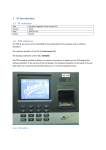
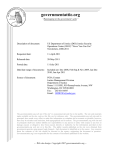




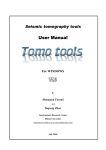
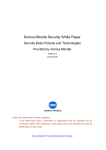

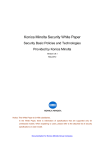
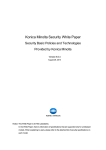
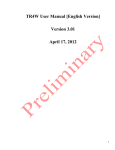
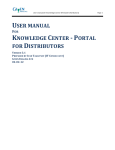

![TR4W User Manual [English Version]](http://vs1.manualzilla.com/store/data/005798737_1-5ae60a1fb1429eafa2ca68266ac47e3b-150x150.png)


